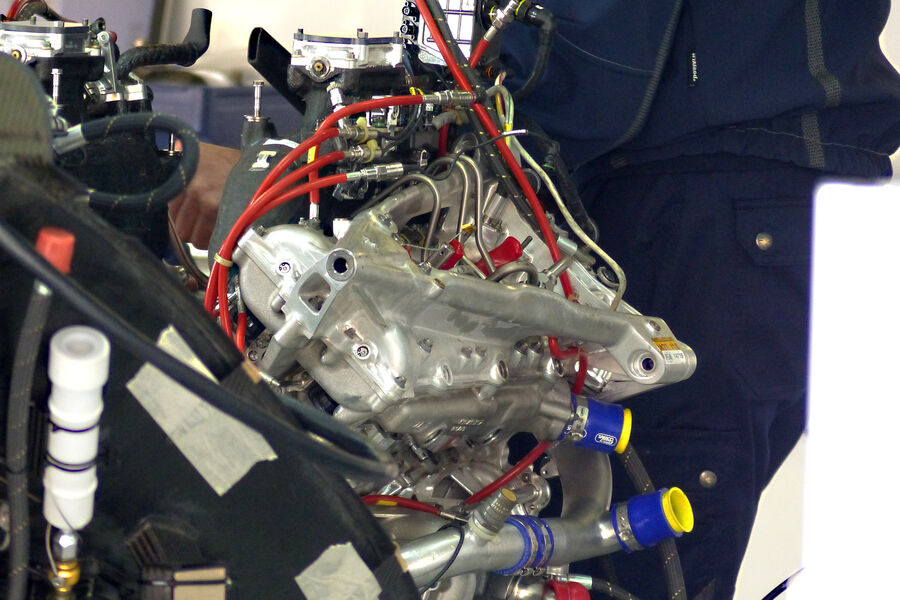atanatizante wrote:
…
4. A new and more powerful fuel formula, something that it`s going to pop somewhere this year or the following years, combined with the added fuel saved by the much improved ERS, are responsible for a much powerful ICE, hence their improved top speeds traps but mostly their top speed sector traps.
…
1. I think the part of much powerful ICE is down to the rule:
5.1.5. Below 10500rpm the fuel mass flow must not exceed Q (kg/h) = 0.009 N(rpm)+ 5.5., isn`t it?
So one could say that in order to have a more powerful ICE one key is to run it
all the time over the 10500rpm bearing in mind the rule :
5.1.4 Fuel mass flow must not exceed 100kg/h.
as the other way around they must run with a “less powerful” fuel rule 5.1.5, isn`t it?
Now you could say they couldn`t do that coz a race is around one and a half hour and had they race all the time with 100kg/h fuel rate they could run out of fuel at some point in the race …
But we must take into account that they are not all time on max. ICE power over a lap, coz they have deceleration periods, pit stops and coasting times … could it be feasible? And could someone tell what % of time they`re spending max. ICE power over a lap?
atanatizante wrote:
…
4. A new and more powerful fuel formula, something that it`s going to pop somewhere this year or the following years, combined with the added fuel saved by the much improved ERS, are responsible for a much powerful ICE, hence their improved top speeds traps but mostly their top speed sector traps.
…
Now according to the rule:
19.1.2 The detailed requirements of this Article are intended to ensure the use of fuels that are composed of compounds normally found in commercial fuels and to prohibit the use of specific power-boosting chemical compounds.
Acceptable compounds and compound classes are defined in 19.2
and 19.4.3. In addition, to cover the presence of low level impurities, the sum of components lying outside the 19.2 and 19.4.3 definitions are limited to 1% max m/m of the total fuel.
This is a very interesting statement IMHO, but nonetheless finally the fuel must comply with the 19.3 fuel properties and 19.4 composition fuel rules and the most important aspect for boosting power are the oxygen and nitrogen rules regarding this matter:
Oxygen … (units): wt% … (max): 3.7 … (Testing method): Elemental Analysis
Nitrogen … (units): mg/kg … (max): 500 … (Testing method): ASTM D 5762
Now another interesting aspect is the 19.4.3 rule which says :
19.4.3 The only oxygenates permitted are paraffinic mono-alcohols and paraffinic mono-ethers with a final boiling point below 210°C.
But this rule must be taken into account with the following rules :
19.4.4 A minimum of 5.75% (m/m) of the fuel must comprise bio-components.
19.4.5 Initially the bio-components are restricted to oxygenates.
However, hydrocarbons (as defined in 19.2) and oxygenates (lying outside the 19.4.3 definition) or mixtures thereof, which have been produced from biomass, may be included in Formula One fuel as part of the 5.75% biocomponents quota, provided that a suitable analytical procedure is available for their quantification and to verify their biological origin. Their use in F1 fuel will be dependent on evidence indicating that the supplier is genuinely developing these compounds for use in commercial fuels.
From my point of view - as a chemical engineer – this above statement together with the 19.4.4 and the oxygen and nitrogen rules are giving some room in R&D for the petrol companies in order to bring more powerful formula and the proof of that is last year official TOTAL member statement which was saying that in 2014 they gain some 40 HP down to the new fuel formulas.
So another reason for the improved Ferrari pace could be also due to a better Shell fuel formula which comprise of – oder then unknown additives – some sort of additives like
MMT/MCMT (Methylcyclopentadienyl manganese tricarbonyl) or Tertiary-Amyl-Ether family additives like TAME (tertiary-amyl methyl ether), TAEE (tertiary-amyl ethyl ether), TABE (tertiary-amyl butyl ether) or improved ones like TAIBE (tertiary-amyl isobutyl ether) and TAIPE (tertiary-amyl isopropyl ether).
Those above fuel additives combined with lubricant additives
Molybdenum Dialkyl Dithiocarbamate (MoDTC) or Molybdenum Dialkyl Dithiophosphate (MoDTP) and of course
those secret nanocomponents in these additives which are are responsible for both powerful fuel formula and fuel economy & less mechanical ICE wear.
And one proof of that theory is Petronas which is responsable for at least 20 to 25 HP more than Mobile1 had provided to McLaren last year and that is according to an official Macca member statement ...











